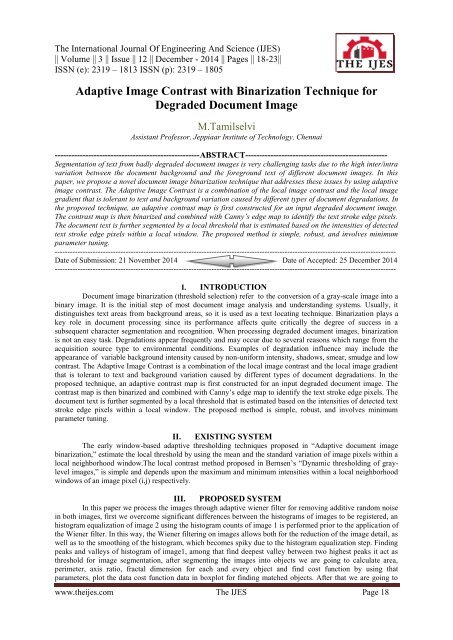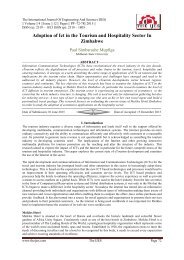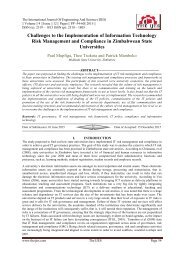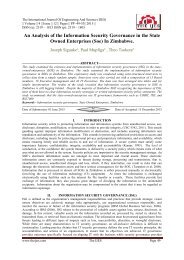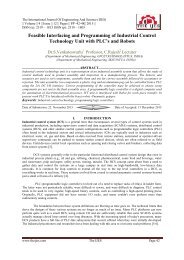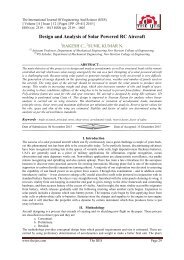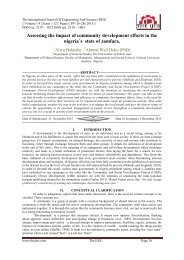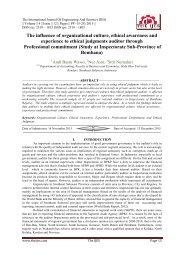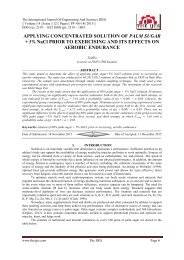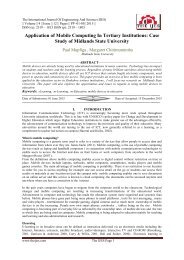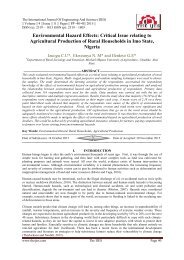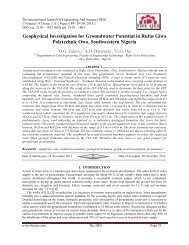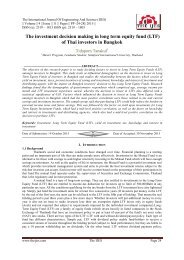Adaptive Image Contrast with Binarization Technique for Degraded Document Image
You also want an ePaper? Increase the reach of your titles
YUMPU automatically turns print PDFs into web optimized ePapers that Google loves.
The International Journal Of Engineering And Science (IJES)<br />
|| Volume || 3 || Issue || 12 || December - 2014 || Pages || 18-23||<br />
ISSN (e): 2319 – 1813 ISSN (p): 2319 – 1805<br />
<strong>Adaptive</strong> <strong>Image</strong> <strong>Contrast</strong> <strong>with</strong> <strong>Binarization</strong> <strong>Technique</strong> <strong>for</strong><br />
<strong>Degraded</strong> <strong>Document</strong> <strong>Image</strong><br />
M.Tamilselvi<br />
Assistant Professor, Jeppiaar Institute of Technology, Chennai<br />
----------------------------------------------------ABSTRACT---------------------------------------------------<br />
Segmentation of text from badly degraded document images is very challenging tasks due to the high inter/intra<br />
variation between the document background and the <strong>for</strong>eground text of different document images. In this<br />
paper, we propose a novel document image binarization technique that addresses these issues by using adaptive<br />
image contrast. The <strong>Adaptive</strong> <strong>Image</strong> <strong>Contrast</strong> is a combination of the local image contrast and the local image<br />
gradient that is tolerant to text and background variation caused by different types of document degradations. In<br />
the proposed technique, an adaptive contrast map is first constructed <strong>for</strong> an input degraded document image.<br />
The contrast map is then binarized and combined <strong>with</strong> Canny’s edge map to identify the text stroke edge pixels.<br />
The document text is further segmented by a local threshold that is estimated based on the intensities of detected<br />
text stroke edge pixels <strong>with</strong>in a local window. The proposed method is simple, robust, and involves minimum<br />
parameter tuning.<br />
---------------------------------------------------------------------------------------------------------------------------------------<br />
Date of Submission: 21 November 2014 Date of Accepted: 25 December 2014<br />
---------------------------------------------------------------------------------------------------------------------------------------<br />
I. INTRODUCTION<br />
<strong>Document</strong> image binarization (threshold selection) refer to the conversion of a gray-scale image into a<br />
binary image. It is the initial step of most document image analysis and understanding systems. Usually, it<br />
distinguishes text areas from background areas, so it is used as a text locating technique. <strong>Binarization</strong> plays a<br />
key role in document processing since its per<strong>for</strong>mance affects quite critically the degree of success in a<br />
subsequent character segmentation and recognition. When processing degraded document images, binarization<br />
is not an easy task. Degradations appear frequently and may occur due to several reasons which range from the<br />
acquisition source type to environmental conditions. Examples of degradation influence may include the<br />
appearance of variable background intensity caused by non-uni<strong>for</strong>m intensity, shadows, smear, smudge and low<br />
contrast. The <strong>Adaptive</strong> <strong>Image</strong> <strong>Contrast</strong> is a combination of the local image contrast and the local image gradient<br />
that is tolerant to text and background variation caused by different types of document degradations. In the<br />
proposed technique, an adaptive contrast map is first constructed <strong>for</strong> an input degraded document image. The<br />
contrast map is then binarized and combined <strong>with</strong> Canny’s edge map to identify the text stroke edge pixels. The<br />
document text is further segmented by a local threshold that is estimated based on the intensities of detected text<br />
stroke edge pixels <strong>with</strong>in a local window. The proposed method is simple, robust, and involves minimum<br />
parameter tuning.<br />
II. EXISTING SYSTEM<br />
The early window-based adaptive thresholding techniques proposed in “<strong>Adaptive</strong> document image<br />
binarization,” estimate the local threshold by using the mean and the standard variation of image pixels <strong>with</strong>in a<br />
local neighborhood window.The local contrast method proposed in Bernsen’s “Dynamic thresholding of graylevel<br />
images,” is simple and depends upon the maximum and minimum intensities <strong>with</strong>in a local neighborhood<br />
windows of an image pixel (i,j) respectively.<br />
III. PROPOSED SYSTEM<br />
In this paper we process the images through adaptive wiener filter <strong>for</strong> removing additive random noise<br />
in both images, first we overcome significant differences between the histograms of images to be registered, an<br />
histogram equalization of image 2 using the histogram counts of image 1 is per<strong>for</strong>med prior to the application of<br />
the Wiener filter. In this way, the Wiener filtering on images allows both <strong>for</strong> the reduction of the image detail, as<br />
well as to the smoothing of the histogram, which becomes spiky due to the histogram equalization step. Finding<br />
peaks and valleys of histogram of image1, among that find deepest valley between two highest peaks it act as<br />
threshold <strong>for</strong> image segmentation, after segmenting the images into objects we are going to calculate area,<br />
perimeter, axis ratio, fractal dimension <strong>for</strong> each and every object and find cost function by using that<br />
parameters, plot the data cost function data in boxplot <strong>for</strong> finding matched objects. After that we are going to<br />
www.theijes.com The IJES Page 18
<strong>Adaptive</strong> <strong>Image</strong> <strong>Contrast</strong> With <strong>Binarization</strong>…<br />
estimate rotation and shift of unregistered image <strong>with</strong> respect to base image and registering base image <strong>with</strong><br />
unregistered image.<br />
IMAGE REGISTRATION : <strong>Image</strong> registration is the process of overlying two or more images of the same<br />
scene taken at different times, from different viewpoints and by different sensors. The major purpose of<br />
registration is to remove or suppress geometric distortions between the reference and sensed images, which were<br />
introduced due to different imaging conditions, and thus to bring images into geometric alignment. <strong>Image</strong><br />
registration is a crucial step in all image analysis tasks in which the final trans<strong>for</strong>mation is obtained by<br />
combining various data sources. Typically, registration is required in remote sensing, as in multispectral<br />
classification, environmental monitoring, image fusion, change detection and weather <strong>for</strong>ecasting, in medicine,<br />
as in combing computed tomography (CT) and nuclear magnetic resonance (NMR) data to obtain more<br />
complete in<strong>for</strong>mation about the patient, monitoring of tumor growth, treatment verification, and in computer<br />
vision, as to target localization and automatic quality control. <strong>Image</strong> registration can be defined as a<br />
determination of one-to-one mapping between the coordinates in one image space and those in another, such<br />
that points in two image spaces that correspond to the same scene point are mapped to each other. In case of<br />
image to scene registration, image coordinates are mapped to the corresponding points in the scene. As an<br />
example of a 2D image, <strong>for</strong> a rigid-body trans<strong>for</strong>mation, the trans<strong>for</strong>mation parameters Tp in (1) consist of three<br />
parameters, two shifts (tx, ty) and a rotation θ<br />
T p (x, y) = +<br />
REFERENCE IMAGE<br />
REFERENCE IMAGE<br />
IMAGE TO BE<br />
REGISTERED<br />
REGISTRATION<br />
Basic Block Diagram of Registration<br />
STRATEGY<br />
REGISTERED IMAGE<br />
IMAGE SEGMENTATION: Generally image segmentation means separating background and <strong>for</strong>eground<br />
image. Thresholding is the simplest method of image segmentation. From a grayscale image, thresholding can<br />
be used to create binary images.<br />
ORIGINAL IMAGE<br />
www.theijes.com The IJES Page 19
<strong>Adaptive</strong> <strong>Image</strong> <strong>Contrast</strong> With <strong>Binarization</strong>…<br />
IV. THRESHOLD EFFECT USED IN IMAGE<br />
Below procedure indicates the general image segmentation procedure. First of all take gray image<br />
(black and white image) and calculate threshold using gray threshold function. Second segment the gray image<br />
using im2bw command<br />
<strong>Adaptive</strong> <strong>Contrast</strong> Enhancement : In this method, a new intensity is assigned to each pixel according to an<br />
adaptive transfer function that is designed on the basis of the local statistics (local minimum maximum as well<br />
as local average intensity). The local min/max/avg of a pixel can be simply defined as the minimal, maximal<br />
and averaging intensities <strong>with</strong>in a local window of a fixed size. This is straight <strong>for</strong>ward to implement but it has<br />
two problems. First, it takes a lot of time to search <strong>for</strong> the local min/max or compute the local aver- age <strong>for</strong> each<br />
pixel. Secondly, the computed min/max maps always manifest some block-lie artifact. In the following we will<br />
compute the local min/max/avg maps using a propagation scheme.<br />
<strong>Document</strong> <strong>Image</strong> <strong>Binarization</strong> : <strong>Document</strong> <strong>Image</strong> <strong>Binarization</strong> is usually per<strong>for</strong>med in the preprocessing stage<br />
of different document image processing related applications such as optical character recognition (OCR) and<br />
document image retrieval. It converts a gray-scale document image into a binary document image and<br />
accordingly facilitates the ensuing tasks such as document skew estimation and document layout analysis. As<br />
more and more text documents are scanned, fast and accurate document image binarization is becoming<br />
increasingly important.<br />
OTSU’S Method : Otsu's method is used to automatically per<strong>for</strong>m clustering-based image threshold or the<br />
reduction of a gray level image to a binary image. The algorithm assumes that the image to be threshold<br />
contains two classes of pixels or bi-modal histogram (e.g. <strong>for</strong>eground and background) then calculates the<br />
optimum threshold separating those two classes so that their combined spread (intra-class variance) is<br />
minimal. The extension of the original method to multi-level threshold is referred to as the Multi Otsu method.<br />
Canny edge detector : The Canny edge detector is an edge detection operator that uses a multistage<br />
algorithm to detect a wide range of edges in images. Canny's aim was to discover the optimal edge<br />
detection algorithm.<br />
Canny Edge Detection Algorithm<br />
The algorithm runs in 5 separate steps:<br />
• Smoothing: Blurring of the image to remove noise.<br />
• Finding gradients: The edges should be marked where the gradients of the image has large magnitudes.<br />
• Non-maximum suppression: Only local maxima should be marked as edges.<br />
• Double thresholding: Potential edges are determined by thresholding.<br />
• Edge tracking by hysteresis: Final edges are determined by suppressing all edges that are not connected to a<br />
very certain (strong) edge.<br />
Local Threshold Estimation : The text can then be extracted from the document back- ground pixels once the<br />
high contrast stroke edge pixels are detected properly. First, the text pixels are close to the detected text stroke<br />
edge pixels. Second, there is a distinct intensity difference between the high contrast stroke edge pixels and the<br />
surrounding background pixels. The neighborhood window should be at least larger than the stroke width in<br />
order to contain stroke edge pixels. So the size of the neighborhood window W can be set based on the stroke<br />
width of the document image under study, EW, which can be estimated from the detected stroke edges.<br />
www.theijes.com The IJES Page 20
<strong>Adaptive</strong> <strong>Image</strong> <strong>Contrast</strong> With <strong>Binarization</strong>…<br />
Post Processing : Problems <strong>with</strong> a picture that require some post processing. Cleaning and sharpening<br />
techniques can reduce noise, increase contrast, tighten the crop of the image, and make other small changes to<br />
the way the picture appears. <strong>Image</strong> post processing can also involve removing things from the frame when they<br />
don't belong or distract. A wildlife photographer, <strong>for</strong> example, might not want a radio tracker implanted on a<br />
bird's wing to be visible, because it could take away from the image. In post processing, the photographer can<br />
carefully edit it out.<br />
<strong>Contrast</strong> <strong>Image</strong> : The image gradient has been widely used <strong>for</strong> edge detection and it can be used to detect the<br />
text stroke edges of the document images effectively that have a uni<strong>for</strong>m document background. On the other<br />
hand, it often detects many non stroke edges from the background of degraded document that often contains<br />
certain image variations due to noise, uneven lighting, bleed-through, etc. To extract only the stroke edges<br />
properly, the image gradient needs to be normalized to compensatethe image variation <strong>with</strong>in the document<br />
background . The local contrast evaluated by the local image maximum and minimum is used to suppress the<br />
background variation. In particular, the numerator (i.e. the difference between the local maximum and the local<br />
minimum) captures the local image difference that is similar to the traditional image gradient .The denominator<br />
is a normalization factor that suppresses the image variation <strong>with</strong>in the document background. For image pixels<br />
<strong>with</strong>in bright regions, it will produce a large normalization factor to neutralize the numerator and accordingly<br />
result in a relatively low image contrast. For the image pixels <strong>with</strong>in dark regions, it will produce a small<br />
denominator and accordingly result in a relatively high image contrast. However, the image contrast in this is a<br />
typical limitation that it may not handle document images <strong>with</strong> the bright text properly. This is because a weak<br />
contrast will be calculated <strong>for</strong> stroke edges of the bright text where the denominator will be large but the<br />
numerator will be small. To overcome this over-normalization problem, we combine the local image contrast<br />
<strong>with</strong> the local image gradient .<br />
Text Stroke Edge Pixel Detection : The purpose of the contrast image construction is to detect the stroke edge<br />
pixels of the document text properly. The constructed contrast image has a clear bi-modal pattern, where the<br />
adaptive image contrast computed at text stroke edges is obviously larger than that computed <strong>with</strong>in the<br />
document background.We there<strong>for</strong>e detect the text stroke edge pixel candidate by using Otsu’s global<br />
thresholding method. For the contrast images a binary map by Otsu’s algorithm that extracts the stroke edge<br />
pixels properly. As the local image contrast and the local image gradient are evaluated by the difference<br />
between the maximum and minimum intensity in a local window, the pixels at both sides of the text stroke will<br />
be selected as the high contrast pixels. The binary map can be further improved through the combination <strong>with</strong><br />
the edges by Canny’s edge detector, because Canny’s edge detector has a good localization property that it can<br />
mark the edges close to real edge locations in the detecting image. In addition, canny edge detector uses two<br />
adaptive thresholds and is more tolerant to different imaging artifacts such as shading . It should be noted that<br />
Canny’s edge detector by itself often extracts a large amount of non-stroke edges <strong>with</strong>out tuning the parameter<br />
manually. In the combined map, we keep only pixels that appear <strong>with</strong>in both the high contrast image pixel map<br />
and canny edge map.The combination helps to extract the text stroke edge pixels accurately.<br />
www.theijes.com The IJES Page 21
<strong>Adaptive</strong> <strong>Image</strong> <strong>Contrast</strong> With <strong>Binarization</strong>…<br />
INPUT<br />
IMAGE<br />
IMGUASSIAN<br />
FILTER<br />
CONTRAST MAP<br />
CONSTRUCTION<br />
EDGE<br />
DETECTION<br />
CONVERTED RGB<br />
INTO<br />
HISTOGRAM<br />
KITTLERMET<br />
(BINEARIZATION<br />
ALGORITHM)<br />
CONVERTED<br />
HISTOGRAM<br />
INTO GRAY<br />
SCALE<br />
POST<br />
PROCESING<br />
IMAGE<br />
EXTRACTION<br />
SEGMENTED<br />
OUTPUT<br />
(a) DEGRADED INPUT IMAGE<br />
(b) GRAY SCALE IMAGE<br />
(c)<br />
www.theijes.com The IJES Page 22
<strong>Adaptive</strong> <strong>Image</strong> <strong>Contrast</strong> With <strong>Binarization</strong>…<br />
(c) BACKGROUND SUPRESSED RECOVERED TEXT IMAGE<br />
IV. CONCLUSION<br />
This paper presents an adaptive image contrast based document image binarization technique that is<br />
tolerant to different types of document degradation such as uneven illumination and document smear. The<br />
proposed technique is simple and robust, only few parameters are involved. Moreover, it works <strong>for</strong> different<br />
kinds of degraded document images. The proposed technique makes use of the local image contrast that is<br />
evaluated based on the local maximum and minimum. The proposed method has been tested on the various<br />
datasets. Experiments show that the proposed method outper<strong>for</strong>ms most reported document binarization<br />
methods in term of the F-measure, pseudo F-measure, PSNR, NRM, MPM and DRD.<br />
REFERENCES<br />
[1] B. Gatos, K. Ntirogiannis, and I. Pratikakis, “ICDAR 2009 documentimage binarization contest (DIBCO 2009),” in Proc. Int.<br />
Conf. <strong>Document</strong> Anal. Recognit., Jul. 2009, pp. 1375–1382.<br />
[2] I. Pratikakis, B. Gatos, and K. Ntirogiannis, “ICDAR 2011 documentimage binarization contest (DIBCO 2011),” in Proc. Int.<br />
Conf. <strong>Document</strong> Anal. Recognit., Sep. 2011, pp. 1506–1510.<br />
[3] I. Pratikakis, B. Gatos, and K. Ntirogiannis, “H-DIBCO 2010 handwritten document image binarization competition,” in Proc.<br />
Int. Conf.Frontiers Handwrit. Recognit., Nov. 2010, pp. 727–732.<br />
[4] S. Lu, B. Su, and C. L. Tan, “<strong>Document</strong> image binarization using background estimation and stroke edges,” Int. J. <strong>Document</strong><br />
Anal. Recognit.,vol. 13, no. 4, pp. 303–314, Dec. 2010.<br />
[5] B. Su, S. Lu, and C. L. Tan, “<strong>Binarization</strong> of historical handwrittendocument images using local maximum and minimum filter,”<br />
in Proc.Int. Workshop <strong>Document</strong> Anal. Syst., Jun. 2010, pp. 159–166.<br />
[6] G. Leedham, C. Yan, K. Takru, J. Hadi, N. Tan, and L. Mian, “Comparison of some thresholding algorithms <strong>for</strong> text/background<br />
segmentation in difficult document images,” in Proc. Int. Conf. <strong>Document</strong> Anal.Recognit., vol. 13. 2003, pp. 859–864.<br />
[7] M. Sezgin and B. Sankur, “Survey over image thresholding techniques and quantitative per<strong>for</strong>mance evaluation,” J. Electron.<br />
Imag., vol. 13,no. 1, pp. 146–165, Jan. 2004.<br />
[8] O. D. Trier and A. K. Jain, “Goal-directed evaluation of binarization methods,” IEEE Trans. Pattern Anal. Mach. Intell., vol. 17,<br />
no. 12, pp. 1191–1201, Dec. 1995.<br />
[9] O. D. Trier and T. Taxt, “Evaluation of binarization methods <strong>for</strong> document images,” IEEE Trans. Pattern Anal. Mach. Intell.,<br />
vol. 17,no. 3, pp. 312–315, Mar. 1995.<br />
[10] A. Brink, “Thresholding of digital images using two-dimensional entropies,” Pattern Recognit., vol. 25, no. 8, pp. 803–808,<br />
1992.<br />
[11] J. Kittler and J. Illingworth, “On threshold selection using clustering criteria,” IEEE Trans. Syst., Man, Cybern., vol. 15, no. 5,<br />
pp. 652–655, Sep.–Oct. 1985.<br />
[12] N. Otsu, “A threshold selection method from gray level histogram,” IEEE Trans. Syst., Man, Cybern., vol. 19, no. 1, pp. 62–66,<br />
Jan. 1979.<br />
[13] N. Papamarkos and B. Gatos, “A new approach <strong>for</strong> multithreshold selection,” Comput. Vis. Graph. <strong>Image</strong> Process., vol. 56, no.<br />
5, pp. 357–370, 1994.<br />
[14] . Bernsen, “Dynamic thresholding of gray-level images,” in Proc. Int. Conf. Pattern Recognit., Oct. 1986, pp. 1251–1255.<br />
[15] L. Eikvil, T. Taxt, and K. Moen, “A fast adaptive method <strong>for</strong> binarization of document images,” in Proc. Int. Conf. <strong>Document</strong><br />
Anal. Recognit., Sep. 1991, pp. 435–443.<br />
[16] I.-K. Kim, D.-W. Jung, and R.-H. Park, “<strong>Document</strong> image binarization based on topographic analysis using a water flow model,”<br />
Pattern Recognit., vol. 35, no. 1, pp. 265–277, 2002.<br />
[17] J. Parker, C. Jennings, and A. Salkauskas, “Thresholding using an illumination model,” in Proc. Int. Conf. Doc. Anal. Recognit.,<br />
Oct. 1993, pp. 270–273.<br />
[18] J. Sauvola and M. Pietikainen, “<strong>Adaptive</strong> document image binarization,”Pattern Recognit., vol. 33, no. 2, pp. 225–236, 2000.<br />
M.Tamilselvi was born in Vellore, Tamilnadu, India in 1983. She received his Bachelor Degree in Electronics and<br />
Communication Engineering from C.Abdul hakeem college of engineering and technology, Anna university affiliated in<br />
the year 2005, Master Degree in VLSI Technology from Sathyabama University in the year 2012. She is working as<br />
Assistant Professor in Department of ECE in Jeppiaar Institute of Technology. His interested areas of research are <strong>Image</strong><br />
Processing and VLSI Design. She is a member of International Association of Engineers (IAENG).<br />
www.theijes.com The IJES Page 23


